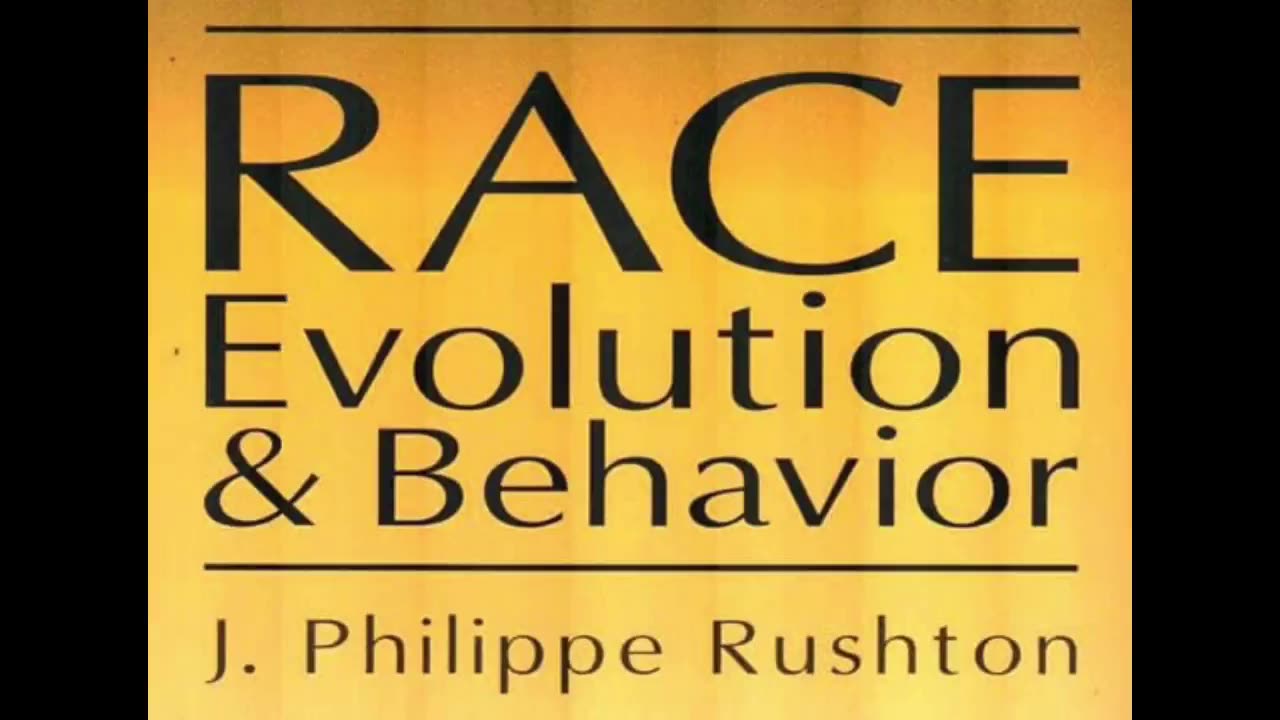Premium Only Content

Race, Evolution & Behavior (1995) | Read by the author J. Philippe Rushton
Full book (PDF): https://odysee.com/@ChaunceyGardiner:5/-J._Philippe_Rushton-_Race,_Evolution,_and_Behavio(b-ok.xyz):e
Using evidence from psychology, anthropology, sociology and other scientific disciplines, this book shows that there are at least three biological races (subspecies) of man Orientals (i.e., Mongoloids or Asians), Blacks (i.e., Negroids or Africans), and Whites (i.e., Caucasoids or Europeans). There are recognizable profiles for the three major racial groups on brain size, intelligence, personality and temperament, sexual behavior, and rates of fertility, maturation and longevity. The profiles reveal that, ON AVERAGE, Orientals and their descendants around the world fall at one end of the continuum, Blacks and their descendants around the world fall at the other end of the continuum, Europeans regularly fall in between. This worldwide pattern implies evolutionary and genetic, rather than purely social, political, economic, or cultural causes.
----
Race, Evolution, and Behavior is one of the most important books about race to be written in many years. Not only does it describe the myriad ways in which the races differ, it advances a persuasive and original explanation for what these differences mean and how they came about. Prof. J. Philippe Rushton of the University of Western Ontario has written a rigorously scholarly book that is not always easy to understand, but it could well become a classic in its field, like Race by John Baker and Bias in Mental Testing by Arthur Jensen.
Just how different are the races? Most experts now take differences in intelligence for granted. Prof. Rushton has gone much farther and marshaled a wealth of data on other important differences. Some of these are summarized on page 3, in a chart that deserves close examination. The most striking finding is not just that Asians, whites, and blacks are different, but that the differences fit a pattern, with Asians and blacks at opposite ends of a spectrum, and whites in the middle.
A large part of the book — and a good portion of this article — are devoted to reviewing these data, but Prof. Rushton’s most provocative and original contribution is his application of what is called r-K theory to this pattern of Asians-whites-blacks. The main features of r-K theory are represented graphically in the drawing on page 3.
Different species have evolved different approaches to propagation. At one extreme is the r-strategy, by which an organism produces a very large number of offspring, but gives them little or no care. The oyster is a good example. Every year it releases millions of eggs into the ocean and leaves them to the mercies of weather and predators. Almost all of them die, but a few survive.
r organisms must mature quickly because they get no help from their parents. The ones that survive repeat the cycle by producing huge numbers of eggs, only a few of which will live. The symbol r stands for the maximum rate of increase in a population, and when the conditions for reproduction are good, an r-strategist can increase its numbers at a terrific rate.
At the other extreme is the K-strategy, which is used by more advanced animals, including man. The number of offspring is much smaller, but great effort is taken to give each one a good chance of survival. K– and r-strategists consequently are very different both in biology and in what Prof. Rushton calls life histories.
K-strategists live longer, have larger brains, and take longer to reach sexual maturity. Unlike the simpler r-strategists, they tend to have some kind of social organization. Besides the care they give their young, adults may share food, cooperate in the hunt, and fight predators together. The K-symbol stands for the carrying capacity of the breeding area, and represents the production of small numbers of offspring that are carefully nurtured for a particular environment.
All humans follow an extreme K-strategy. They have few young, who take years to mature and require a great deal of care. They have large brains and complex societies based on cooperation. However, human races are not identical. The chart on page 3 shows that Asians consistently show more K behavior than whites, who in turn show more than blacks. There is virtually no departure from this pattern.
Maturation and Reproduction
In almost every respect, racial differences in the physiology of reproduction show an r-K pattern that runs from blacks to whites to Asians. Fraternal twinning, for example, which happens when a mother releases more than one egg during ovulation, is clearly an r-strategy of producing more and smaller young, who are more likely to be miscarried, be born underweight, die in infancy, and receive less parental care.
Fraternal twinning is twice as common among blacks as among whites, and twice as common among whites as among Asians. Triplets are ten times more common among whites than among Asians and 17 times more common among Africans than among whites. In some African populations, multiple births account for 60 out of every 1,000. In Japan, where twins are very rare, they are viewed suspiciously as the products of a “litter,” more akin to dogs than to humans.
Offspring of the different races gestate and mature according to different r-K strategies. Blacks are born earlier and smaller than whites, but are stronger and better coordinated. They can sit up and roll over sooner than whites, who can do so sooner than Asians. On average, blacks walk at age 11 months, whites at 12 months, and Asians at 13 months.
Although it is a specialized measure of development, permanent tooth eruption occurs sooner in Africans than in Europeans, and later in Asians. Among primates in general, there is near-perfect correlation between lateness of permanent tooth eruption and such things as length of life, brain size, years to maturity, and complexity of social organization.
Blacks reach sexual maturity sooner than whites, who reach it sooner than Asians. By age twelve, 19 percent of American black girls have fully developed breasts and pubic hair whereas only five percent of white girls do. Blacks, on average, have an earlier first menstruation than whites, and Asians menstruate later than whites. In the United States, the average white woman is two full years older than the average black woman when she first has sexual intercourse, and Asians start having intercourse even later than whites.
Professor Rushton has bravely taken on the delicate subject of genital size, which has received reluctant but official attention because of AIDS. International organizations that try to provide condoms to people all over the world have discovered that one size does not fit all. Blacks have larger penises than whites, who have larger penises than Asians. The length of the vagina also differs proportionately in each race. Black men produce more sperm than do whites, and Asian men produce the least.
In the United States, black married couples report the greatest frequency of sexual intercourse, and Asian married couples report the lowest frequency. AIDS, like other sexually transmitted disease, is most common among blacks, rarest among Asians.
In Africa, compared to Europe or Asia, it is common to have sexual relations with many partners and to expend less effort on child-rearing. Older brothers and sisters often look after smaller children. There are also huge racial and regional differences in the number of offspring produced. In the United States, the average woman produces 14 children, grand children and great-grand children; in Africa the figure is 258. This prodigious African reproductive effort takes place over a shorter life-span. Blacks do not live as long as whites who, in turn, do not live as long as Asians.
Here, clearly, are patterns of maturational and reproductive behavior that show a consistent r-K pattern. Quick maturity, early reproduction, numerous offspring, and shorter lives put blacks closer to the oyster end of the scale than whites, who are closer to it than Asians.
Differences in sexual activity, life-span, and number of children are usually attributed to “culture” or “environment,” but there is every reason to believe that they are at least partly genetic, just as size of sex organs or age of sexual maturity are almost entirely genetic. Life-span, for example, is clearly hereditary in part. The age at which an adopted child will die is more easily predicted from the life-spans of the biological parents than from those of the adoptive parents. Likewise, identical twins die, on average, only 37 months apart whereas fraternal twins die 78 months apart.
What about the other components of the human K-strategy, such as altruism, law-abidingness, and the other characteristics that make up distinctly human social organizations? To what extent are what we think of as personality — and the cultural institutions that reflect a population’s group personality — the products of heredity, and thus properly included in an analysis of r-K strategy? Prof. Rushton has exhaustively surveyed recent studies of heredity, which suggest a powerful genetic influence on virtually all aspects of human behavior.
-
 DVR
DVR
LFA TV
22 hours agoTrump Has Learned His Lesson | Trumpet Daily 11.21.24 7PM EST
12.2K4 -
 LIVE
LIVE
theDaily302
11 hours agoThe Daily 302-Special Border Invasion Shutdown Show
154 watching -
 4:29:05
4:29:05
Tate Speech by Andrew Tate
12 hours agoEMERGENCY MEETING EPISODE 92 - IN THE TRENCHES
748K1.01K -
 1:01:23
1:01:23
In The Litter Box w/ Jewels & Catturd
1 day agoThe Trump Effect | In the Litter Box w/ Jewels & Catturd – Ep. 696 – 11/21/2024
81.4K31 -
 20:53
20:53
SLS - Street League Skateboarding
2 days agoGold Medals, World Class Food, Night life & more - Get Lost: Tokyo
75.9K7 -
 47:13
47:13
PMG
20 hours ago $1.26 earned"Hannah Faulkner and Doug Billings | WHY LIBERALS LOST THE ELECTION"
41.9K -
 59:01
59:01
The Liberty Lobbyist
6 hours ago"We Only Have NOW To Make a Difference"
42K2 -
 4:16:41
4:16:41
CatboyKami
8 hours agoStalker 2 Blind playthrough pt1
40.9K2 -
 1:06:27
1:06:27
Russell Brand
8 hours agoNeil Oliver on the Rise of Independent Media, Cultural Awakening & Fighting Centralized Power –SF498
214K284 -
 1:39:14
1:39:14
vivafrei
8 hours agoSoros Karma in New York! Tammy Duckwarth Spreads LIES About Tulsi Gabbard! Pennsylvania FLIPS & MORE
105K79